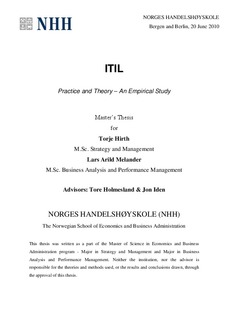| dc.description.abstract | Through this thesis we attempt to acquire general knowledge about how to make the best use
of ITIL and how to implement it sensibly in real-life situations. This aim is achieved by
studying relevant literature, conducting qualitative and quantitative research, upon which we
eventually make our analysis and conclusions.
ITIL is a framework for best-practice IT Service Management (ITSM) based on consensus
recommendations from IT practitioners from all over the world. We give a short presentation
of the field of IT Service Management and the related field of process management
whereupon we try to give a brief, but to-the-point presentation of the core ITIL literature.
We continue with a literature study on organizations and communication to understand the
backdrop against which any IT project will take place. Thereafter we narrow down our focus
when going through characteristics of projects, project management and the pertaining PSO
(abbr. for People, System, Organization) perspective, as well as change management. An
ITIL implementation is typically carried out through the means of a project implying
changes not only to the Systems at work in the IT department, but also to the People and the
Organization. Our empirical data are based on an ITSM status survey conducted in the Nordic countries as
well as interviews with three experienced Norwegian practitioners. This gave us data on
ITIL progress and viewpoints among Nordic companies in addition to in-depth, partly tacit
information from well-respected ITIL practitioners. We compared our theoretical
understanding to how it corresponded to the experiences of our interviewees and the results
from the survey. Based upon what we learned from this process we have launched six propositions (see
Chapter 5.1). The purpose of the propositions is to keep our analysis discussion structured
and goal-oriented. In addition we now propose our two general research questions, with
which we try to formulate the main problem of our thesis. We will also cover more
specificities and related features in our analysis and discussion of our propositions in
Chapters 5 and 6.
Research Question 1: How can ITIL be useful to organizations and IT departments, and how
could it be introduced optimally to different organizations? In other words: Is there a
universal introduction recipe?
We find reasons and benefits for why both small and large IT departments should implement
ITIL, although ITIL needs adaptation and a pragmatic approach for it to work purposefully
in a specific situation. The reasons for choosing ITIL vary, but they all rest on the fundament
that ITIL, when used sensibly, gives more efficient IT Service Management. We conclude
that there is no universal introduction recipe. However, the implementation may be aided
positively by the help of an external consultant that is unaffected of internal power structures
and able to see the organization from an out-of-the-box perspective. To internalize process
thinking among IT employees is typically a time-consuming process.
Research Question 2: How can one deal with the change process that ITIL initiates? We conclude that one must be vigilant when dealing with the soft aspects of change –
implementing a technical system supporting ITIL processes can be done quick and easy.
However, internalizing ITSM and process thinking among employees and an organization
that have not before worked in such a manner is more challenging. To be aware of
developing the people and the organization parallel with the development of ITIL-supporting
systems can be a key to reducing resistance to the change an ITIL project may bring about.
Applying such a parallel focus, called PSO, may even create understanding for the necessary
changes so that people begin supporting the ITIL initiative and start engaging in its success.
Another specific recommendation for making the IT employees understand the benefit of
using ITIL and be positive towards the upcoming change may be to first introduce some of
the ITIL‟s operative processes, thus achieving so-called quick-wins, i.e. showing with
immediate effect how ITIL can enhance the efficiency of the IT department by its structured
way of working. | en |
